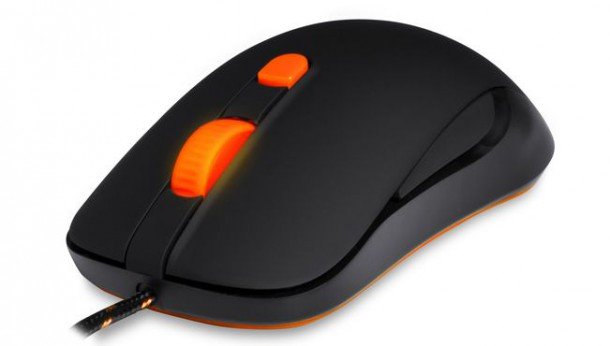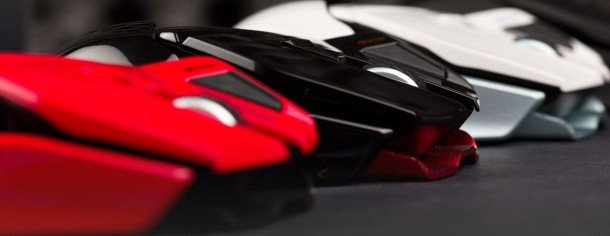Steelseries talk mouse design, sensors, weight and the wireless future

A good mouse is instantly forgotten. Whether you prefer a finger-grip or a flat-palm stance, once you've found a good mouse it seems to vanish from consideration the moment you touch it. It's just an extension of your will. A lot of work goes into the design and construction of the modern mouse to achieve this effect, so we asked Steelseries' chief technical officer, Tino Soelberg, what constructors consider when creating new designs, and to speculate a little on the future of these vital peripherals.
Wes Fenlon, PC Gamer: Technology for gaming mice has changed a lot over the past 10-15 years, when you're looking at sensors and on the software side. Do you think, in general, the design work that goes into how the mouse fits your hand, or the types of materials that are used to make it, has that stuff changed a lot?
Soelberg: Yes, there's a lot of changes. And it keeps evolving, right? There are always new materials coming out. For something like the Rival, one of the biggest changes has been the sides that it has. It has direct-injected [rubber] sides. We had nice soft touch coatings on our other mice, but that's something we haven't done before. And it's something you some other manufacturers doing as well, now. No one did that 10 years ago, even five years ago. So there's development in all areas of mice, right? It's not just sensors.
PC Gamer: When you're making a new mouse and designing a new model, what is the process of choosing the right sensor for that mouse?
Soelberg: You have to start with the concept of the mouse. What is the end goal? What is the price target for this mouse? Sometimes the end goal determines the price target as well. It depends project to project. Sometimes you will go very aggressively after some specific price target, sometimes it's a little bit more of a holistic feature. For the Rival, we had a very clear goal to spend money on performance. And almost everything else, we almost didn't care about. The packaging isn't flashy, stuff like that.
From there, understanding what the whole concept of the mouse is, and then you get to choose. It's not like a kid in a candy store. There's a fairly limited number of sensors, at least in our case, that we actually feel are up to par with what we want, and specifically for something like [the Rival]. This is, in many cases, a hardcore FPS mouse, so tracking is more important than super high CPI. And then it comes down to a selection of what's trending in the market and what's upcoming. On this one, if I remember correctly, we were probably the first guys to use the [Avago] 3310.
And then there's working with the sensor companies. You can't do anything with these sensors unless you work directly with Avago or Pixart. Then you just get vanilla components. And you have a lot of gaming mice out there, and gaming mice that actually have the same sensor, but there's a lot more than just fitting the sensor. You have to work with the teams to get the right firmware in the sensors as well. At least most of our mice have custom firmware in the sensor, so it might be the same [sensor model] number you see in another mouse, but the firmware is always custom.
The biggest gaming news, reviews and hardware deals
Keep up to date with the most important stories and the best deals, as picked by the PC Gamer team.

PC Gamer: That was actually going to be my follow-up question. From the research I've done into sensors, it seems like the same mouse sensor can perform pretty differently depending on the mouse it's in. I assume that's mostly, or completely, due to the firmware. Can you talk about what goes into customizing that firmware?
Soelberg: There's lots of stuff that goes into performance. The sensor itself is a fairly simple thing. You have to design around that. Anything from the pure mechanical design of making sure you're actually designed to the specification, that's the mechanical engineering part. We all use more or less the same lenses. Then there's the LED choice as well. The illumination source, obviously, is very important. Controlling that LED, or controlling the illumination source, when you turn on or off and how much you're powered and how much you're willing to spend on that LED, has to do with performance.
And then there's the last part, which is firmware. That comes down to what you prefer for a mouse. It's like tuning cars. Is this car going to be really good at driving up hills, or is it going to be able to drive really fast on straightaways? The sensor performance definitely depends on how that firmware is tuned in those cases. It can be a very large variety.
Vanilla firmware on these sensors are normally pretty good. They perform pretty okay in most cases. But you can definitely tune these things so they are better at acceleration, or better at really high speed movements, or at very precise details. And sensor firmware has a lot to do with how the sensor copes with what happens when it's not really tracking. There's some guesswork that the sensor firmware has to do when it drops the tracking, and how that guesswork is done, some of the parameters around that, all goes into the firmware. You only get that by working with the sensor manufacturers.
PC Gamer: So they'll give you the vanilla firmware, and then you'll work with them, both your engineers and theirs, to collaborate and suit the firmware to your needs?
Soelberg: Yeah, we work closely with their guys. None of us actually have access directly to that firmware. But we work very closely with the team. Pixart is Taiwanese, and our main engineering team is in Taipei as well, so they work directly with these guys on a daily basis.
PC Gamer: Let's talk about mouse weight a little bit. How does your team choose how heavy a mouse is going to be? When I talk to a lot of casual PC gamers, they tend to prefer heavier mice. But pro gamers I've talk to always want their mouse to be as lightweight as absolutely possible. How do you make that decision?
Soelberg: We go as light as we can. We go as light as we can with the industrial design we want, the design features we want. So something like the Rival, some of the weight we get from the rubber side panels. But we have never, and you'll see this in any of our mice, we've never deliberately added any kind of weight in there. And most likely we're not going to do that. We come from a background of really working with the pro guys, and that's really how we develop everything. We have these guys on the sidelines at all times. I don't expect us to do anything with weight adjustments or something like that. We're trying to go as light as we can. We're not building carbon fibre stuff, but yeah. You won't' see weight adjustment stuff from us.
PC Gamer: I think that's a good thing. I know some people like those, but they seem like a gimmick, and some of the pro players I've talked to just say that just gives you an excuse to blame the mouse for something, like "oh, I had too many weight in there!"
Soelberg: It does seem a little bit gimmicky, and you know, it costs money, that stuff. If I put in a weight system, I'd have to take out cost in something else. And I'd rather spend the cost on getting the right sensor in there, or the right switches. Being able to use my own switches instead of buying something cheaper. I'd rather spend money on that than some gimmicky stuff like weight systems.

PC Gamer: What do you think is next on the horizon for gaming mice? What still needs to be improved?
Soelberg: One thing is wireless. I think we've all just gotten our toes wet. I think we're at a point now where the wireless performance of something like the Sensei wireless is at a level where we felt very safe and secure in releasing that. We get great feedback on it, so I'm sure you'll see more wireless stuff coming out, because the performance is there now. We don't have the performance issues that people had, let's just say, wireless mice that came out five, four, even three years ago. But now the performance is really there. If you look across the board, it's not just us—I think wireless is picking up.
From the Steelseries side, if you look at our product cycles, the Ikari came out with all its tech and functionality, and then the Sai, and then the Sensei with its 32-bit ARM processor, all that tech and functionality, it doesn't take a rocket scientist to see that it's been awhile since the Sensei came out, and it wouldn't be strange to expect something coming out in that range of product.
PC Gamer: So you guys might be cooking up a follow-up, huh?
Soelberg: The Sensei has been around for a couple years. If you just look at overall specs, sensor choice, at least for the MLG version that has the [Avago] 9800, and the whole onboard system, that's still virtually unbeatable right now. But you know, it's becoming an older product, so I wouldn't be surprised if you were going to see something there. [laughs]
PC Gamer: When it comes to updating a design like that, what are the limitations on our mice currently that putting in a faster processor is going to improve? Or are there other factors you'll be able to improve?
It's other factors that we can improve. Obviously there's a little bit on the sensor. That was one has a 9800, so there's some stuff we can do on the processor...I can't get too much into it, but it's not just processor. Some ways around how you work with that system, that onboard system. There are different things. It's not just upgrading. The hardware itself is not that different. We have so much processing power in there. I mean, the ARM Cortex-M3 that's in the Sensei already, the thing can run Quake [laughs].

Wes has been covering games and hardware for more than 10 years, first at tech sites like The Wirecutter and Tested before joining the PC Gamer team in 2014. Wes plays a little bit of everything, but he'll always jump at the chance to cover emulation and Japanese games.
When he's not obsessively optimizing and re-optimizing a tangle of conveyor belts in Satisfactory (it's really becoming a problem), he's probably playing a 20-year-old Final Fantasy or some opaque ASCII roguelike. With a focus on writing and editing features, he seeks out personal stories and in-depth histories from the corners of PC gaming and its niche communities. 50% pizza by volume (deep dish, to be specific).

